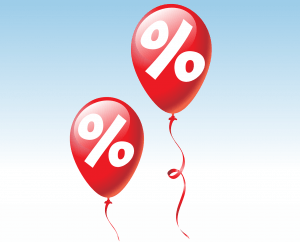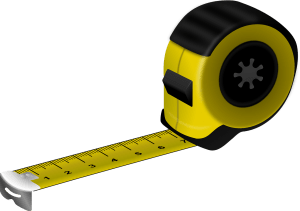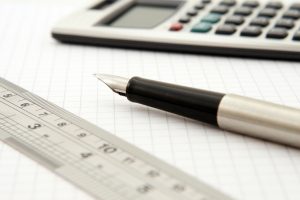I’m often told by people that they don’t use maths at work, or at home, so they can’t really see the point of having to learn it at school. Whilst there are many aspects of maths that are only used in very specific careers, there are some basics that everyone should master as you never know when you might need them.
- Finding a percentage discount.
This is an important maths skill if you are selling, or buying, a product at a discounted price. If you don’t have a calculator handy, chunking is the best method to use. If you have a difficult number, it is easier to round to something you can work with.
Example:
There is a 20% discount on a jacket that originally cost £59.99.
Round to £60 for ease.
Chunking tells you to find 10% first by dividing by 10.
60 divided by 10 is 6.
To find 20% double your answer (you need two lots of 10%).
6 doubled is £12.
The discount will be £12.
Remember this is the discount not the price you pay – to find that subtract the 12 from the 60 to give £48.
Be aware that if you round at the beginning, the final cost may be a few pence different.
2. Understanding how averages can be manipulated.
Many businesses or organisations use averages in their marketing to give credence to their claims. It is important to know how these averages can be used to present things in either a positive or negative light. It can be done by selecting the type of average which suits what you want to portray or by selecting the sample group or size to give the desired results.
Example:
Customers were asked to rate a new product out of 10. These are the results:
6, 5, 8, 8, 7, 8, 5, 3, 4, 9, 6, 7, 3, 4
Mean = 5.9 (add up all the values and divide by how many values you have so, in this case, 83 divided by 14 rounded to one decimal place)
Median = 6 (put the values in order and then find the middle value)
Mode/modal = 8 (the most common value)
To make the product seem more popular the seller may choose to use the modal value and say the average rating was 8 out of 10.
It is important to know how these averages can be manipulated for both your own use and when viewing statistics produced by others.
3. Working out the percentage profit.
A crucial maths skill to get right if you want to make money from selling your goods. Many new businesses don’t fully take into account the costs before deciding upon a selling price.
The formula to use is
new value – original value x 100
original value
This could also be worded as
selling price – cost price x 100
cost price
For example: You are selling a box of beauty products for £46. Your costs come to £25. Follow the formula to give:
46 – 25 = 21 (this is the actual profit made in pounds).
21/46 x 100= 45.65 (to 2 decimal places).
Your percentage profit is therefore 46%.
The same formula can be used to work out a percentage increase or decrease in price. If a supplier has put up their costs, you can work out what percentage they have increased the price by to see if it is reasonable or not.
4. Using units correctly.
People work in various units when measuring and this can cause confusion and mistakes that can cost both time and money. Some people still work with imperial units such as feet, inches and stones whereas others use metric units such as centimetres, kilograms and litres. Always be clear about the units you are using.
If you are selling an item and listing the dimensions/weight etc, it might be worth giving the information in both imperial and metric to suit the needs of different customers.
Example:
A seller describes a piece of boarding as four by two and sends 200 units to the buyer. When it arrives, the buyer rings up to complain as he was sent boards of 4 feet by 2 feet and he was expecting pieces 4m by 2m. This would be extremely costly in terms of time, potential wastage, customer satisfaction and transport costs.
5. Working with basic formulae.
There are some formulae that are used across multiple professions such as mileage calculations, profit calculations (such as the example above) and currency conversion. Some professions may need to follow set formulae. An example would be a welder finding the width of a weld cap using the formula W = 2(tan b x t) + g. If you are presented with a formula in your line of work, you would probably be expected to know how to input values correctly even if you have not seen the formula before.
Two basic things you should know about are the priciples of BODMAS or BIDMAS and the fact that when numbers and letters touch they times (multiply) as the x symbol is not used in algebra to represent multiplication.
BODMAS or BIDMAS tells you the order to carry out a calculation in: Brackets, Order/Index/Indices, Divide, Multiply, Add then Subtract.
Examples:
Many mileage calculations are based on a rate of 45p per mile. As a formula, this could be written as:
c = 0.45m
c would be the cost in pounds and m would be the number of miles. A journey of 35 miles would be worked out as 0.45 X 35 = 15.75
So the total cost would be £15.75
Currency conversions can really confuse people but the formulae are very simple.
For example: to convert between euros and pounds use the following formulae:
E= RP
or rearranged it is
P = E/R
E is the amount in Euros
P is the amount in pounds
R is the conversion rate
The current conversion is £1 = €1.34
This means the rate is 1.34
Put the amounts you want into the formulae.
If you want to convert £350 into Euros, you would do:
E= RP
E= 1.34 X 350
E = 469
So £350 is €469
If you want to convert €60 into pounds, you would do:
P = E/R
P = 60/1.34
P = 44.78
So €60 = £44.78
Quick Tricks!
You can also look for quick tricks to help you work things out in your head.
1.34 is approximately 4/3 because 0.3 is a third and 1 is equivalent to 3/3 so in total you have four thirds. 4/3 means divide by 3 and multiply by 4 so to change from pounds to euros use this method.
Example:
£30 divided by 3 is 10
multiply 10 by 4 to give 40 so £30 is approximately €40
To change from euros to pounds use the opposite method: divide by four and multiply by three.
Example:
€40 divided by four is 10
Multiply 10 by three to give 30 so €40 is approximately £30
If you can master these maths skills, you should be able to carry out any basic maths you need to within your workplace. However, there will be many people who struggle with maths because they hated it in school and have avoided it ever since. If you, or an employee/colleague, would like to improve your maths skills please get in touch to see if I can help. You can improve your skills with averages and graphs with our free online course here. Many adults also enjoy the BBC Skillswise materials.
Lyn Calver


